Evaluating Organizational Culture Issues with a Diverse Workforce
VerifiedAdded on 2022/04/12
|7
|2039
|41
Report
AI Summary
This report delves into the critical issues organizations encounter when managing a diverse workforce and its impact on organizational culture. It examines the challenges and benefits of workforce diversity, including leadership, innovation, productivity, and growth. The report analyzes potential problems such as conflict, harassment, and disregarding individual needs, while also discussing the implications for International Human Resource Management (IHRM). It covers cross-cultural management, language barriers, and the importance of ethical strategies and diversity management. The report also highlights the need for formal guidelines, empathy training, and regular progress checks to manage workplace diversity effectively, offering insights into how HR managers can address these challenges and foster a supportive organizational culture. It emphasizes the importance of senior management involvement and HR manager actions in creating a successful and inclusive work environment.
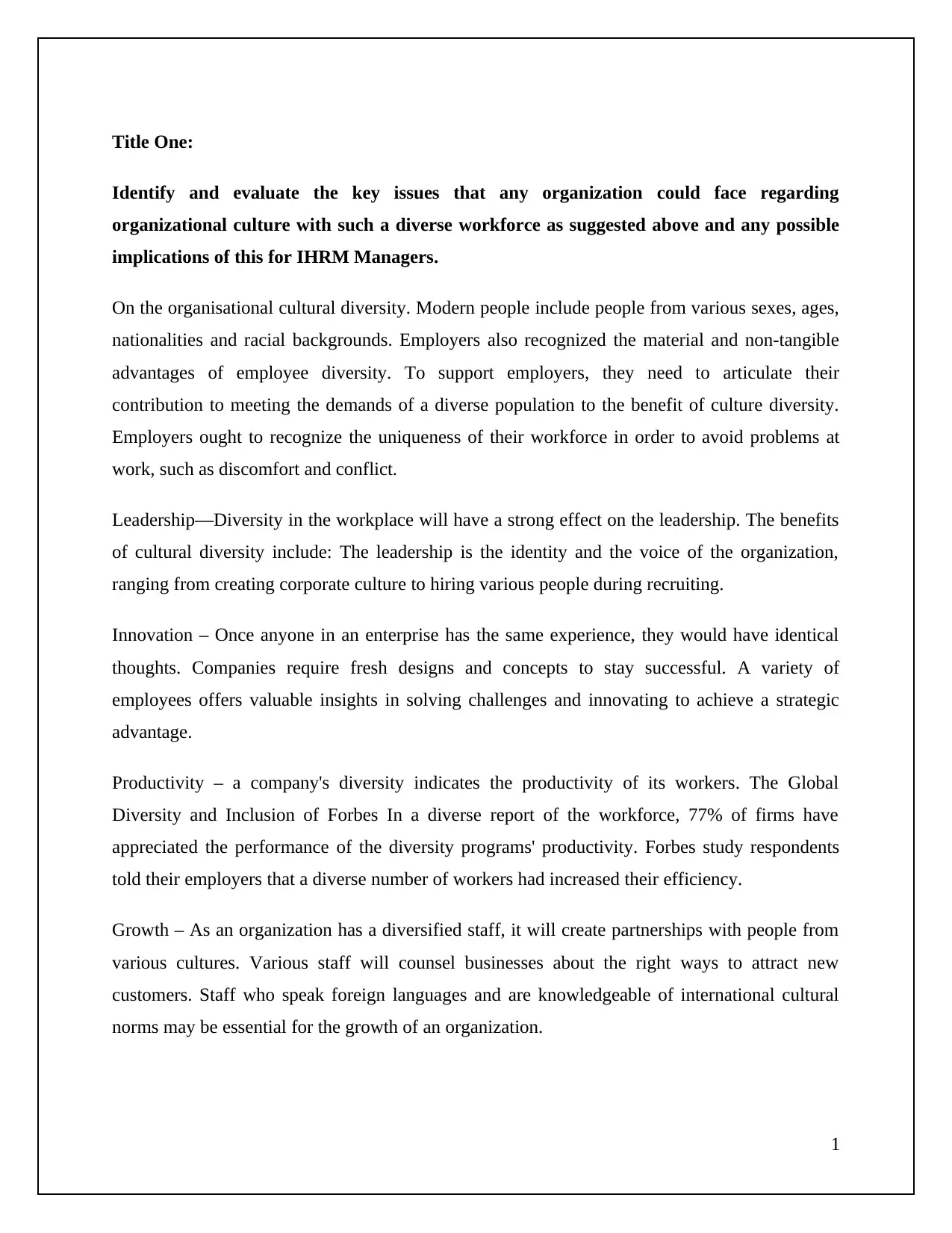
Title One:
Identify and evaluate the key issues that any organization could face regarding
organizational culture with such a diverse workforce as suggested above and any possible
implications of this for IHRM Managers.
On the organisational cultural diversity. Modern people include people from various sexes, ages,
nationalities and racial backgrounds. Employers also recognized the material and non-tangible
advantages of employee diversity. To support employers, they need to articulate their
contribution to meeting the demands of a diverse population to the benefit of culture diversity.
Employers ought to recognize the uniqueness of their workforce in order to avoid problems at
work, such as discomfort and conflict.
Leadership—Diversity in the workplace will have a strong effect on the leadership. The benefits
of cultural diversity include: The leadership is the identity and the voice of the organization,
ranging from creating corporate culture to hiring various people during recruiting.
Innovation – Once anyone in an enterprise has the same experience, they would have identical
thoughts. Companies require fresh designs and concepts to stay successful. A variety of
employees offers valuable insights in solving challenges and innovating to achieve a strategic
advantage.
Productivity – a company's diversity indicates the productivity of its workers. The Global
Diversity and Inclusion of Forbes In a diverse report of the workforce, 77% of firms have
appreciated the performance of the diversity programs' productivity. Forbes study respondents
told their employers that a diverse number of workers had increased their efficiency.
Growth – As an organization has a diversified staff, it will create partnerships with people from
various cultures. Various staff will counsel businesses about the right ways to attract new
customers. Staff who speak foreign languages and are knowledgeable of international cultural
norms may be essential for the growth of an organization.
1
Identify and evaluate the key issues that any organization could face regarding
organizational culture with such a diverse workforce as suggested above and any possible
implications of this for IHRM Managers.
On the organisational cultural diversity. Modern people include people from various sexes, ages,
nationalities and racial backgrounds. Employers also recognized the material and non-tangible
advantages of employee diversity. To support employers, they need to articulate their
contribution to meeting the demands of a diverse population to the benefit of culture diversity.
Employers ought to recognize the uniqueness of their workforce in order to avoid problems at
work, such as discomfort and conflict.
Leadership—Diversity in the workplace will have a strong effect on the leadership. The benefits
of cultural diversity include: The leadership is the identity and the voice of the organization,
ranging from creating corporate culture to hiring various people during recruiting.
Innovation – Once anyone in an enterprise has the same experience, they would have identical
thoughts. Companies require fresh designs and concepts to stay successful. A variety of
employees offers valuable insights in solving challenges and innovating to achieve a strategic
advantage.
Productivity – a company's diversity indicates the productivity of its workers. The Global
Diversity and Inclusion of Forbes In a diverse report of the workforce, 77% of firms have
appreciated the performance of the diversity programs' productivity. Forbes study respondents
told their employers that a diverse number of workers had increased their efficiency.
Growth – As an organization has a diversified staff, it will create partnerships with people from
various cultures. Various staff will counsel businesses about the right ways to attract new
customers. Staff who speak foreign languages and are knowledgeable of international cultural
norms may be essential for the growth of an organization.
1
Paraphrase This Document
Need a fresh take? Get an instant paraphrase of this document with our AI Paraphraser
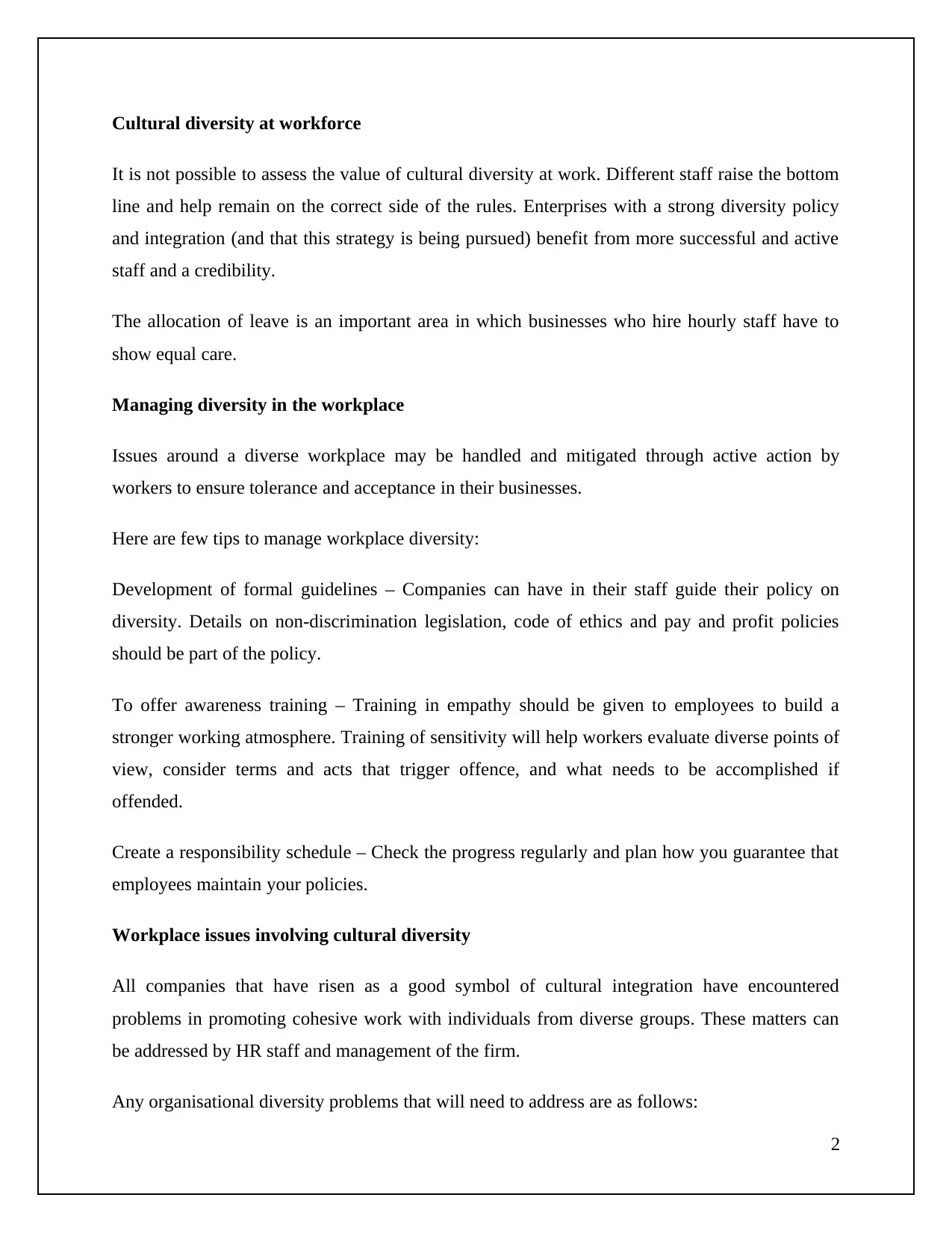
Cultural diversity at workforce
It is not possible to assess the value of cultural diversity at work. Different staff raise the bottom
line and help remain on the correct side of the rules. Enterprises with a strong diversity policy
and integration (and that this strategy is being pursued) benefit from more successful and active
staff and a credibility.
The allocation of leave is an important area in which businesses who hire hourly staff have to
show equal care.
Managing diversity in the workplace
Issues around a diverse workplace may be handled and mitigated through active action by
workers to ensure tolerance and acceptance in their businesses.
Here are few tips to manage workplace diversity:
Development of formal guidelines – Companies can have in their staff guide their policy on
diversity. Details on non-discrimination legislation, code of ethics and pay and profit policies
should be part of the policy.
To offer awareness training – Training in empathy should be given to employees to build a
stronger working atmosphere. Training of sensitivity will help workers evaluate diverse points of
view, consider terms and acts that trigger offence, and what needs to be accomplished if
offended.
Create a responsibility schedule – Check the progress regularly and plan how you guarantee that
employees maintain your policies.
Workplace issues involving cultural diversity
All companies that have risen as a good symbol of cultural integration have encountered
problems in promoting cohesive work with individuals from diverse groups. These matters can
be addressed by HR staff and management of the firm.
Any organisational diversity problems that will need to address are as follows:
2
It is not possible to assess the value of cultural diversity at work. Different staff raise the bottom
line and help remain on the correct side of the rules. Enterprises with a strong diversity policy
and integration (and that this strategy is being pursued) benefit from more successful and active
staff and a credibility.
The allocation of leave is an important area in which businesses who hire hourly staff have to
show equal care.
Managing diversity in the workplace
Issues around a diverse workplace may be handled and mitigated through active action by
workers to ensure tolerance and acceptance in their businesses.
Here are few tips to manage workplace diversity:
Development of formal guidelines – Companies can have in their staff guide their policy on
diversity. Details on non-discrimination legislation, code of ethics and pay and profit policies
should be part of the policy.
To offer awareness training – Training in empathy should be given to employees to build a
stronger working atmosphere. Training of sensitivity will help workers evaluate diverse points of
view, consider terms and acts that trigger offence, and what needs to be accomplished if
offended.
Create a responsibility schedule – Check the progress regularly and plan how you guarantee that
employees maintain your policies.
Workplace issues involving cultural diversity
All companies that have risen as a good symbol of cultural integration have encountered
problems in promoting cohesive work with individuals from diverse groups. These matters can
be addressed by HR staff and management of the firm.
Any organisational diversity problems that will need to address are as follows:
2
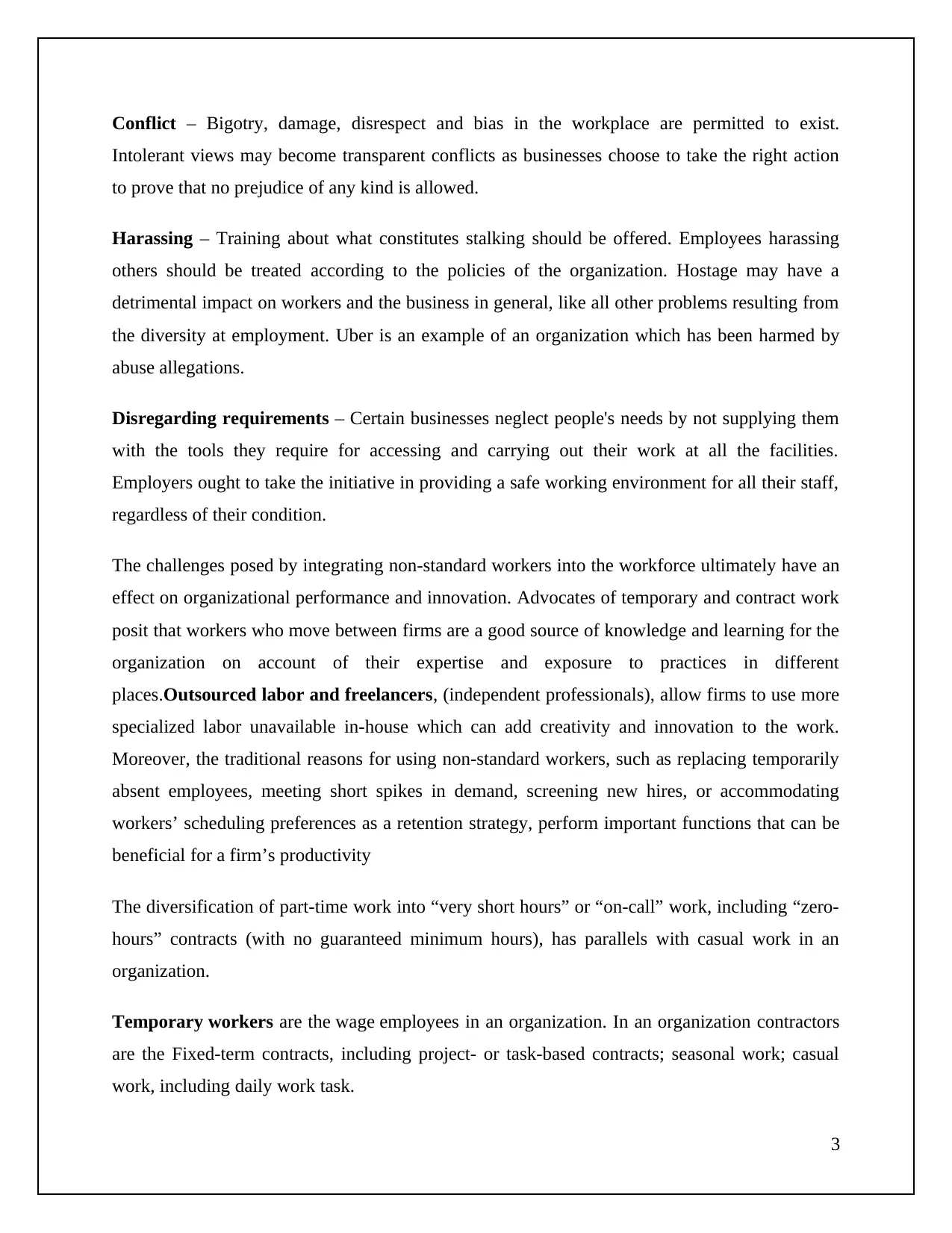
Conflict – Bigotry, damage, disrespect and bias in the workplace are permitted to exist.
Intolerant views may become transparent conflicts as businesses choose to take the right action
to prove that no prejudice of any kind is allowed.
Harassing – Training about what constitutes stalking should be offered. Employees harassing
others should be treated according to the policies of the organization. Hostage may have a
detrimental impact on workers and the business in general, like all other problems resulting from
the diversity at employment. Uber is an example of an organization which has been harmed by
abuse allegations.
Disregarding requirements – Certain businesses neglect people's needs by not supplying them
with the tools they require for accessing and carrying out their work at all the facilities.
Employers ought to take the initiative in providing a safe working environment for all their staff,
regardless of their condition.
The challenges posed by integrating non-standard workers into the workforce ultimately have an
effect on organizational performance and innovation. Advocates of temporary and contract work
posit that workers who move between firms are a good source of knowledge and learning for the
organization on account of their expertise and exposure to practices in different
places.Outsourced labor and freelancers, (independent professionals), allow firms to use more
specialized labor unavailable in-house which can add creativity and innovation to the work.
Moreover, the traditional reasons for using non-standard workers, such as replacing temporarily
absent employees, meeting short spikes in demand, screening new hires, or accommodating
workers’ scheduling preferences as a retention strategy, perform important functions that can be
beneficial for a firm’s productivity
The diversification of part-time work into “very short hours” or “on-call” work, including “zero-
hours” contracts (with no guaranteed minimum hours), has parallels with casual work in an
organization.
Temporary workers are the wage employees in an organization. In an organization contractors
are the Fixed-term contracts, including project- or task-based contracts; seasonal work; casual
work, including daily work task.
3
Intolerant views may become transparent conflicts as businesses choose to take the right action
to prove that no prejudice of any kind is allowed.
Harassing – Training about what constitutes stalking should be offered. Employees harassing
others should be treated according to the policies of the organization. Hostage may have a
detrimental impact on workers and the business in general, like all other problems resulting from
the diversity at employment. Uber is an example of an organization which has been harmed by
abuse allegations.
Disregarding requirements – Certain businesses neglect people's needs by not supplying them
with the tools they require for accessing and carrying out their work at all the facilities.
Employers ought to take the initiative in providing a safe working environment for all their staff,
regardless of their condition.
The challenges posed by integrating non-standard workers into the workforce ultimately have an
effect on organizational performance and innovation. Advocates of temporary and contract work
posit that workers who move between firms are a good source of knowledge and learning for the
organization on account of their expertise and exposure to practices in different
places.Outsourced labor and freelancers, (independent professionals), allow firms to use more
specialized labor unavailable in-house which can add creativity and innovation to the work.
Moreover, the traditional reasons for using non-standard workers, such as replacing temporarily
absent employees, meeting short spikes in demand, screening new hires, or accommodating
workers’ scheduling preferences as a retention strategy, perform important functions that can be
beneficial for a firm’s productivity
The diversification of part-time work into “very short hours” or “on-call” work, including “zero-
hours” contracts (with no guaranteed minimum hours), has parallels with casual work in an
organization.
Temporary workers are the wage employees in an organization. In an organization contractors
are the Fixed-term contracts, including project- or task-based contracts; seasonal work; casual
work, including daily work task.
3
⊘ This is a preview!⊘
Do you want full access?
Subscribe today to unlock all pages.

Trusted by 1+ million students worldwide
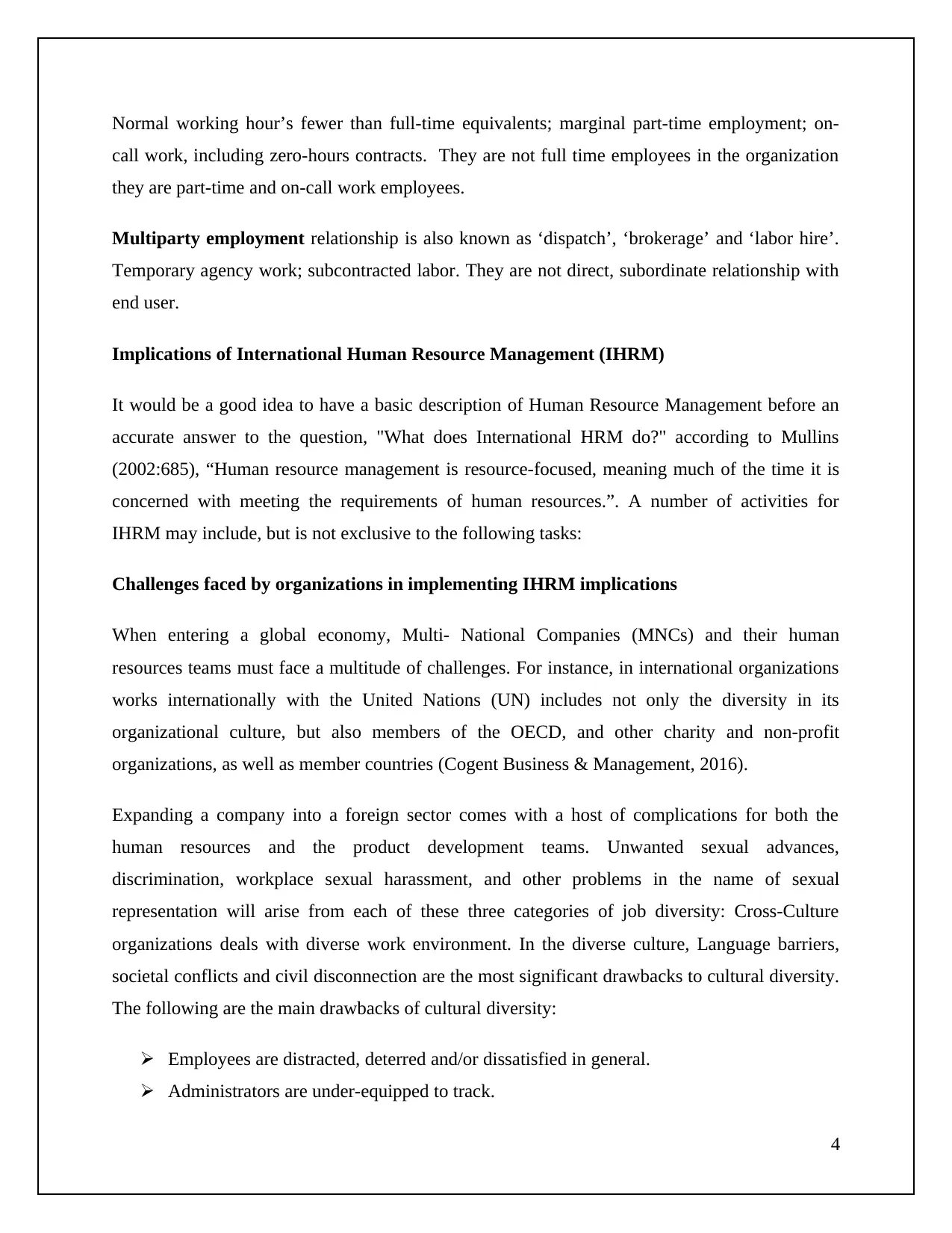
Normal working hour’s fewer than full-time equivalents; marginal part-time employment; on-
call work, including zero-hours contracts. They are not full time employees in the organization
they are part-time and on-call work employees.
Multiparty employment relationship is also known as ‘dispatch’, ‘brokerage’ and ‘labor hire’.
Temporary agency work; subcontracted labor. They are not direct, subordinate relationship with
end user.
Implications of International Human Resource Management (IHRM)
It would be a good idea to have a basic description of Human Resource Management before an
accurate answer to the question, "What does International HRM do?" according to Mullins
(2002:685), “Human resource management is resource-focused, meaning much of the time it is
concerned with meeting the requirements of human resources.”. A number of activities for
IHRM may include, but is not exclusive to the following tasks:
Challenges faced by organizations in implementing IHRM implications
When entering a global economy, Multi- National Companies (MNCs) and their human
resources teams must face a multitude of challenges. For instance, in international organizations
works internationally with the United Nations (UN) includes not only the diversity in its
organizational culture, but also members of the OECD, and other charity and non-profit
organizations, as well as member countries (Cogent Business & Management, 2016).
Expanding a company into a foreign sector comes with a host of complications for both the
human resources and the product development teams. Unwanted sexual advances,
discrimination, workplace sexual harassment, and other problems in the name of sexual
representation will arise from each of these three categories of job diversity: Cross-Culture
organizations deals with diverse work environment. In the diverse culture, Language barriers,
societal conflicts and civil disconnection are the most significant drawbacks to cultural diversity.
The following are the main drawbacks of cultural diversity:
Employees are distracted, deterred and/or dissatisfied in general.
Administrators are under-equipped to track.
4
call work, including zero-hours contracts. They are not full time employees in the organization
they are part-time and on-call work employees.
Multiparty employment relationship is also known as ‘dispatch’, ‘brokerage’ and ‘labor hire’.
Temporary agency work; subcontracted labor. They are not direct, subordinate relationship with
end user.
Implications of International Human Resource Management (IHRM)
It would be a good idea to have a basic description of Human Resource Management before an
accurate answer to the question, "What does International HRM do?" according to Mullins
(2002:685), “Human resource management is resource-focused, meaning much of the time it is
concerned with meeting the requirements of human resources.”. A number of activities for
IHRM may include, but is not exclusive to the following tasks:
Challenges faced by organizations in implementing IHRM implications
When entering a global economy, Multi- National Companies (MNCs) and their human
resources teams must face a multitude of challenges. For instance, in international organizations
works internationally with the United Nations (UN) includes not only the diversity in its
organizational culture, but also members of the OECD, and other charity and non-profit
organizations, as well as member countries (Cogent Business & Management, 2016).
Expanding a company into a foreign sector comes with a host of complications for both the
human resources and the product development teams. Unwanted sexual advances,
discrimination, workplace sexual harassment, and other problems in the name of sexual
representation will arise from each of these three categories of job diversity: Cross-Culture
organizations deals with diverse work environment. In the diverse culture, Language barriers,
societal conflicts and civil disconnection are the most significant drawbacks to cultural diversity.
The following are the main drawbacks of cultural diversity:
Employees are distracted, deterred and/or dissatisfied in general.
Administrators are under-equipped to track.
4
Paraphrase This Document
Need a fresh take? Get an instant paraphrase of this document with our AI Paraphraser
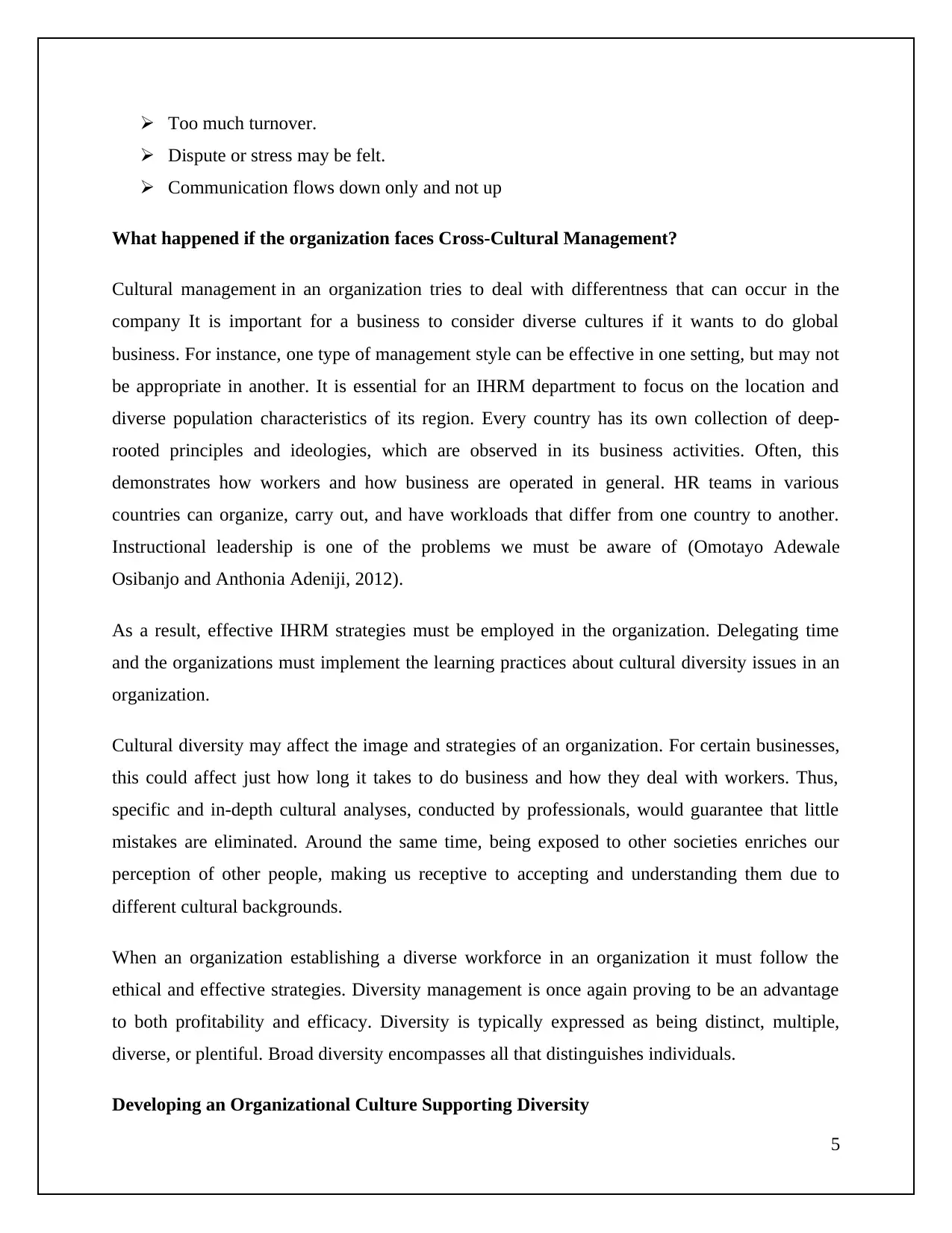
Too much turnover.
Dispute or stress may be felt.
Communication flows down only and not up
What happened if the organization faces Cross-Cultural Management?
Cultural management in an organization tries to deal with differentness that can occur in the
company It is important for a business to consider diverse cultures if it wants to do global
business. For instance, one type of management style can be effective in one setting, but may not
be appropriate in another. It is essential for an IHRM department to focus on the location and
diverse population characteristics of its region. Every country has its own collection of deep-
rooted principles and ideologies, which are observed in its business activities. Often, this
demonstrates how workers and how business are operated in general. HR teams in various
countries can organize, carry out, and have workloads that differ from one country to another.
Instructional leadership is one of the problems we must be aware of (Omotayo Adewale
Osibanjo and Anthonia Adeniji, 2012).
As a result, effective IHRM strategies must be employed in the organization. Delegating time
and the organizations must implement the learning practices about cultural diversity issues in an
organization.
Cultural diversity may affect the image and strategies of an organization. For certain businesses,
this could affect just how long it takes to do business and how they deal with workers. Thus,
specific and in-depth cultural analyses, conducted by professionals, would guarantee that little
mistakes are eliminated. Around the same time, being exposed to other societies enriches our
perception of other people, making us receptive to accepting and understanding them due to
different cultural backgrounds.
When an organization establishing a diverse workforce in an organization it must follow the
ethical and effective strategies. Diversity management is once again proving to be an advantage
to both profitability and efficacy. Diversity is typically expressed as being distinct, multiple,
diverse, or plentiful. Broad diversity encompasses all that distinguishes individuals.
Developing an Organizational Culture Supporting Diversity
5
Dispute or stress may be felt.
Communication flows down only and not up
What happened if the organization faces Cross-Cultural Management?
Cultural management in an organization tries to deal with differentness that can occur in the
company It is important for a business to consider diverse cultures if it wants to do global
business. For instance, one type of management style can be effective in one setting, but may not
be appropriate in another. It is essential for an IHRM department to focus on the location and
diverse population characteristics of its region. Every country has its own collection of deep-
rooted principles and ideologies, which are observed in its business activities. Often, this
demonstrates how workers and how business are operated in general. HR teams in various
countries can organize, carry out, and have workloads that differ from one country to another.
Instructional leadership is one of the problems we must be aware of (Omotayo Adewale
Osibanjo and Anthonia Adeniji, 2012).
As a result, effective IHRM strategies must be employed in the organization. Delegating time
and the organizations must implement the learning practices about cultural diversity issues in an
organization.
Cultural diversity may affect the image and strategies of an organization. For certain businesses,
this could affect just how long it takes to do business and how they deal with workers. Thus,
specific and in-depth cultural analyses, conducted by professionals, would guarantee that little
mistakes are eliminated. Around the same time, being exposed to other societies enriches our
perception of other people, making us receptive to accepting and understanding them due to
different cultural backgrounds.
When an organization establishing a diverse workforce in an organization it must follow the
ethical and effective strategies. Diversity management is once again proving to be an advantage
to both profitability and efficacy. Diversity is typically expressed as being distinct, multiple,
diverse, or plentiful. Broad diversity encompasses all that distinguishes individuals.
Developing an Organizational Culture Supporting Diversity
5
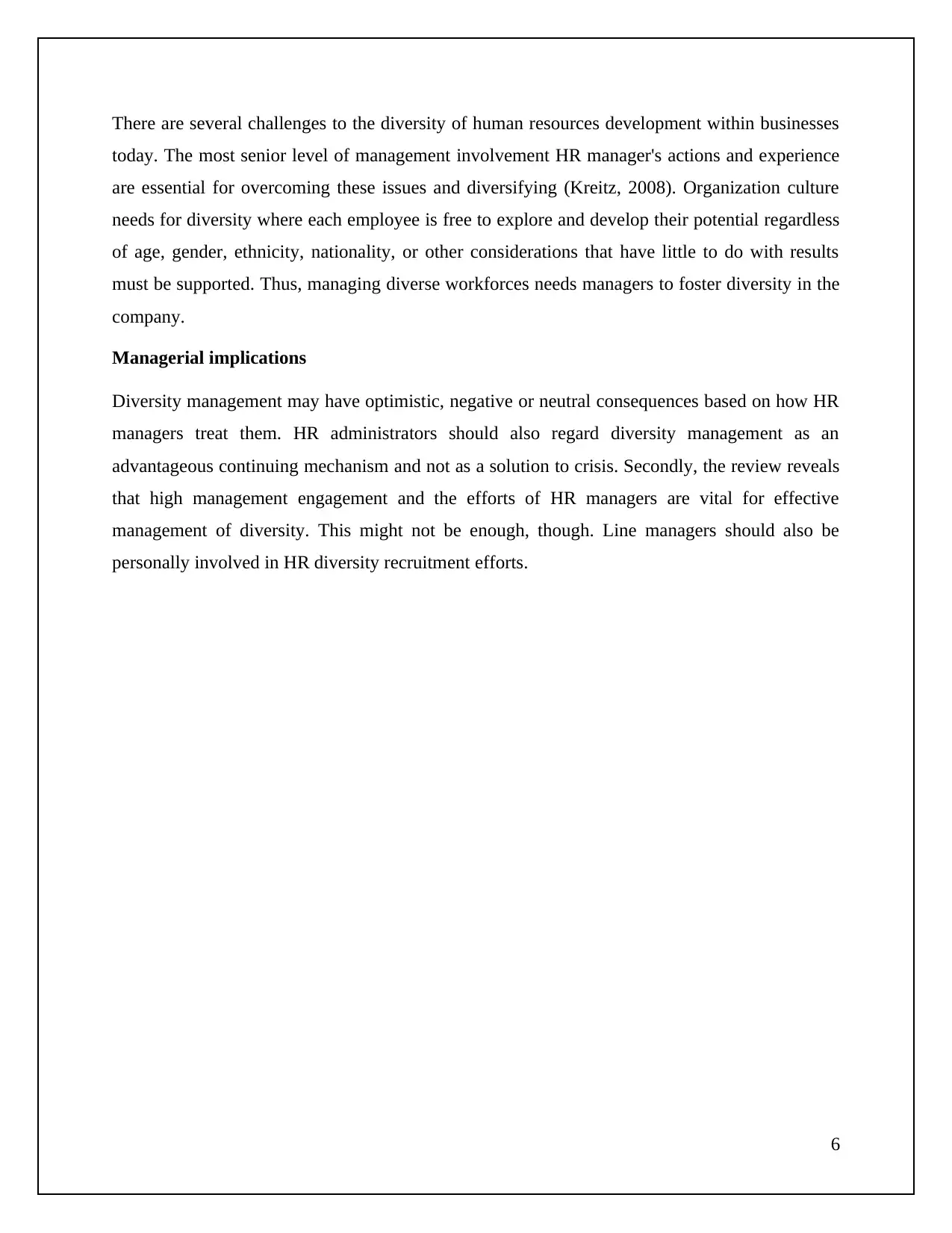
There are several challenges to the diversity of human resources development within businesses
today. The most senior level of management involvement HR manager's actions and experience
are essential for overcoming these issues and diversifying (Kreitz, 2008). Organization culture
needs for diversity where each employee is free to explore and develop their potential regardless
of age, gender, ethnicity, nationality, or other considerations that have little to do with results
must be supported. Thus, managing diverse workforces needs managers to foster diversity in the
company.
Managerial implications
Diversity management may have optimistic, negative or neutral consequences based on how HR
managers treat them. HR administrators should also regard diversity management as an
advantageous continuing mechanism and not as a solution to crisis. Secondly, the review reveals
that high management engagement and the efforts of HR managers are vital for effective
management of diversity. This might not be enough, though. Line managers should also be
personally involved in HR diversity recruitment efforts.
6
today. The most senior level of management involvement HR manager's actions and experience
are essential for overcoming these issues and diversifying (Kreitz, 2008). Organization culture
needs for diversity where each employee is free to explore and develop their potential regardless
of age, gender, ethnicity, nationality, or other considerations that have little to do with results
must be supported. Thus, managing diverse workforces needs managers to foster diversity in the
company.
Managerial implications
Diversity management may have optimistic, negative or neutral consequences based on how HR
managers treat them. HR administrators should also regard diversity management as an
advantageous continuing mechanism and not as a solution to crisis. Secondly, the review reveals
that high management engagement and the efforts of HR managers are vital for effective
management of diversity. This might not be enough, though. Line managers should also be
personally involved in HR diversity recruitment efforts.
6
⊘ This is a preview!⊘
Do you want full access?
Subscribe today to unlock all pages.

Trusted by 1+ million students worldwide
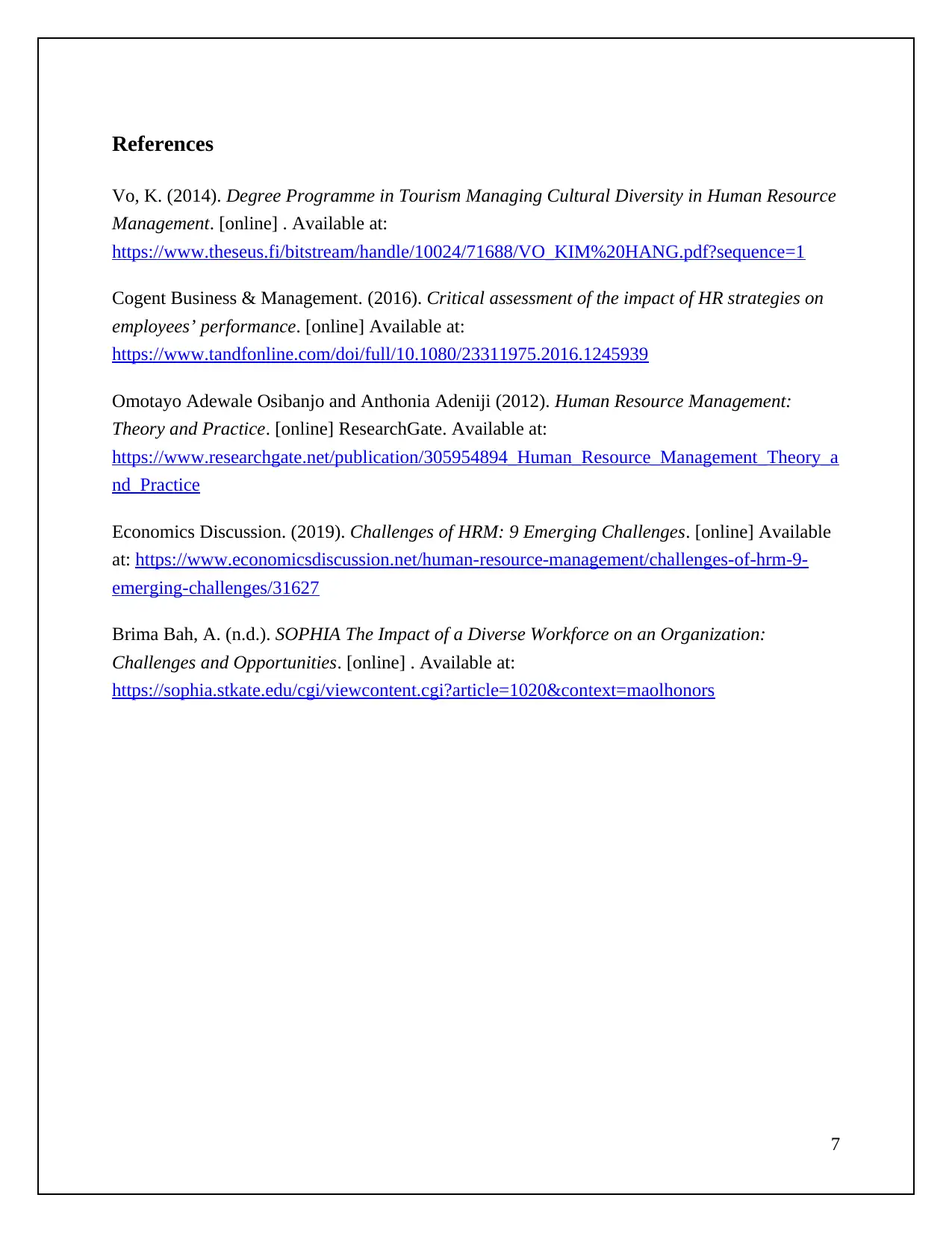
References
Vo, K. (2014). Degree Programme in Tourism Managing Cultural Diversity in Human Resource
Management. [online] . Available at:
https://www.theseus.fi/bitstream/handle/10024/71688/VO_KIM%20HANG.pdf?sequence=1
Cogent Business & Management. (2016). Critical assessment of the impact of HR strategies on
employees’ performance. [online] Available at:
https://www.tandfonline.com/doi/full/10.1080/23311975.2016.1245939
Omotayo Adewale Osibanjo and Anthonia Adeniji (2012). Human Resource Management:
Theory and Practice. [online] ResearchGate. Available at:
https://www.researchgate.net/publication/305954894_Human_Resource_Management_Theory_a
nd_Practice
Economics Discussion. (2019). Challenges of HRM: 9 Emerging Challenges. [online] Available
at: https://www.economicsdiscussion.net/human-resource-management/challenges-of-hrm-9-
emerging-challenges/31627
Brima Bah, A. (n.d.). SOPHIA The Impact of a Diverse Workforce on an Organization:
Challenges and Opportunities. [online] . Available at:
https://sophia.stkate.edu/cgi/viewcontent.cgi?article=1020&context=maolhonors
7
Vo, K. (2014). Degree Programme in Tourism Managing Cultural Diversity in Human Resource
Management. [online] . Available at:
https://www.theseus.fi/bitstream/handle/10024/71688/VO_KIM%20HANG.pdf?sequence=1
Cogent Business & Management. (2016). Critical assessment of the impact of HR strategies on
employees’ performance. [online] Available at:
https://www.tandfonline.com/doi/full/10.1080/23311975.2016.1245939
Omotayo Adewale Osibanjo and Anthonia Adeniji (2012). Human Resource Management:
Theory and Practice. [online] ResearchGate. Available at:
https://www.researchgate.net/publication/305954894_Human_Resource_Management_Theory_a
nd_Practice
Economics Discussion. (2019). Challenges of HRM: 9 Emerging Challenges. [online] Available
at: https://www.economicsdiscussion.net/human-resource-management/challenges-of-hrm-9-
emerging-challenges/31627
Brima Bah, A. (n.d.). SOPHIA The Impact of a Diverse Workforce on an Organization:
Challenges and Opportunities. [online] . Available at:
https://sophia.stkate.edu/cgi/viewcontent.cgi?article=1020&context=maolhonors
7
1 out of 7
Related Documents
Your All-in-One AI-Powered Toolkit for Academic Success.
+13062052269
info@desklib.com
Available 24*7 on WhatsApp / Email
![[object Object]](/_next/static/media/star-bottom.7253800d.svg)
Unlock your academic potential
Copyright © 2020–2025 A2Z Services. All Rights Reserved. Developed and managed by ZUCOL.





